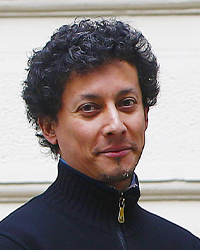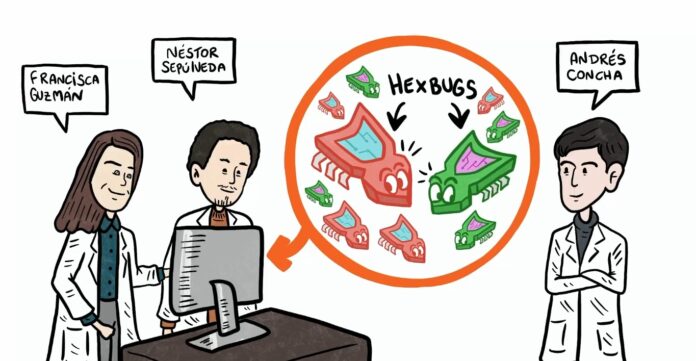 The researchers of the Millennial Nucleus Physics of Active Matter, Néstor Sepúlveda (UAI) and Francisca Guzmán (DFC-U. Chile) together with Andrés Concha (UAI), created computational simulations and an experimental model with more than 100 magnetic mini-robots to study the behavior of magnetotactic bacteria, which is under investigation by various scientists because of its potential use in biomedicine.
The researchers of the Millennial Nucleus Physics of Active Matter, Néstor Sepúlveda (UAI) and Francisca Guzmán (DFC-U. Chile) together with Andrés Concha (UAI), created computational simulations and an experimental model with more than 100 magnetic mini-robots to study the behavior of magnetotactic bacteria, which is under investigation by various scientists because of its potential use in biomedicine.
The Magnetotactic bacteria are a group of aquatic microorganisms that lives in rivers, swamps, and lakes of the world characterized for having a chain of magnetic nanoparticles called magnetosome, which is a sort of backbone magnets that function as a compass and permits them to orientate according to the magnetic field of the Earth so they can swim and guide in pursuit of nutrients in the low oxygen zones, which is the environment they need to reproduce.
Science has focused on this quality due to its potential use as microrobots with medical applications since, through the application of external magnetic fields, it could be possible to control them. It has become crucial for science to know more about their behavior and unravel how they unfold in diverse scenarios.
 In 2016, Francisca Guzmán, Principal Researcher at the Millennium Nucleus Physics of Active Matter and professor at the Physics Department (DFC) at Universidad de Chile conducted a study -published in Nature magazine- which analyzed the behavior of artificial magnetic bacteria. In this study, she discovered that bacteria colonies could organize themselves by forming chains and whirlpools, among other diverse configurations (unknown until then), depending on different necessities.
In 2016, Francisca Guzmán, Principal Researcher at the Millennium Nucleus Physics of Active Matter and professor at the Physics Department (DFC) at Universidad de Chile conducted a study -published in Nature magazine- which analyzed the behavior of artificial magnetic bacteria. In this study, she discovered that bacteria colonies could organize themselves by forming chains and whirlpools, among other diverse configurations (unknown until then), depending on different necessities.
Two years after, Andrés Concha, Dr. In Physics and Professor at Adolfo Ibáñez University (UAI), decided to conduct an experimental study to see if the configurations at a microscopic level, Dr. Francisca Guzmán has discovered, would repeat at a macro level with larger objects, visible to the naked eye. The chosen objects for this experiment were hexbugs, a sort of robotic insects, the size of a toothbrush head, used in diverse physics investigations.
 In 2019, the team conformed by Dr. Concha (UAI) and Dr. Guzmán (DFC-U. Chile), besides Néstor Sepúlveda, Principal Researcher of the Millennium Nucleus and Professor at the UAI, put a hundred of these mini-robots in a circular corral. They added a shell with a magnet to each one of them so that they could study their movements.
In 2019, the team conformed by Dr. Concha (UAI) and Dr. Guzmán (DFC-U. Chile), besides Néstor Sepúlveda, Principal Researcher of the Millennium Nucleus and Professor at the UAI, put a hundred of these mini-robots in a circular corral. They added a shell with a magnet to each one of them so that they could study their movements.
Néstor Sepúlveda, an expert in computational physics applied to biology, performed the computational simulations to register the motions of these little colonies of robots and entitled them with the magnetic bacteria characteristics, but now, at a macro scale. “We were able to control the velocity thanks to the battery they were using and the intensity of the magnets that we were changing to observe the different behaviors.” Said Francisca Guzmán, Dr. in Fluodynamics.
Biological limit
The investigation -published by arXiv– showed robots behaved the same as bacteria at a microscopic level, forming structures like chains, whirlpools, and other configurations. However, they also observed that when the intensity of the magnet was higher, robots ceased to form these figures to form pairs that rotated endlessly. “That tells us there is a biological limit to the magnetism these microorganisms have in real life and, because they are incapable of controlling their movements in pairs, they could not survive.” Says the researcher.
Besides, the experiments revealed that not only the passive systems (not self-propelled) have metastable configurations (or low energy) when magnetically interacting. Active systems can also have them but in a different way. “In passive particles exists certain metastable configurations because the system is in equilibrium when the magnetic interaction occurs. But when there is movement or some activity, we observed some metastable states also appear. From a physical point of view, this is very interesting since we have not experimentally seen it.”
The results of this investigation may impact whether in physics, ecology, and medicine since knowing more about the biological limits of these magnetic bacteria and their behavior during collective swimming permit the study of new states and configurations in the active systems. It is important to understand how they have evolved and the significance of the colony life in their natural ecological niche, besides having more information when using them in potential biomedical research to repair tissues or distribute medicine straight to tumors. In fact, a team of researchers from the Millennium Nucleus, headed by Dr. María Luisa Cordero, are working precisely on that, besides many other scientists researching the same topic.
You can see the investigation in this animated capsule financed by the MPE program from Iniciativa Científica Milenio, ANID Center, Ministry of Science, Technology, Knowledge and Innovation, Chile.


